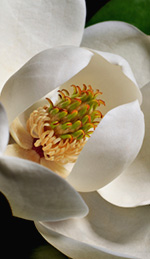 The magnolia is one of the most well-traveled flowers in the world, with species in South Asia, the Pacific, and North America. The magnolia essential oil we offer at the Essential Oil Exchange is steam distilled from the flowers of Michelia alba, a hybrid species created by crossing the South Asian Magnolia champaca with Magnolia montana. Our magnolia essential oil is pale to orangish yellow with a crisp, green, not too floral scent with a tropical-fruity hint!
The magnolia is one of the most well-traveled flowers in the world, with species in South Asia, the Pacific, and North America. The magnolia essential oil we offer at the Essential Oil Exchange is steam distilled from the flowers of Michelia alba, a hybrid species created by crossing the South Asian Magnolia champaca with Magnolia montana. Our magnolia essential oil is pale to orangish yellow with a crisp, green, not too floral scent with a tropical-fruity hint!
The magnolia plant has broad green leaves and large white flowers with spear-shaped petals that exude an alluring scent. Also called white champaca, white sandalwood, and white jade orchid tree, magnolia flowers have been used in traditional Chinese medicine for hundreds of years to move qi, the vital force that regulates the body’s organ systems [1]. Practitioners of traditional Chinese medicine believe that when qi becomes blocked or stagnant, illness is the result. A fragrant tea known as yulan is also steeped from magnolia flowers in China, and the blossoms are used in temple ceremonies in India to mark life milestones such as births, deaths, and religious holidays. In South Asia, the scent of magnolia flowers is associated with renewal, growth, and new beginnings.
The uses of magnolia essential oil in aromatherapy are many, and more aromatherapists continue to discover its roster of therapeutic uses every day. As an antimicrobial and antiseptic agent, magnolia oil is often diffused to treat respiratory infections [2], and may also offer relief for allergenic reactions and congestion [3]. The oil is also sometimes applied topically to reduce fevers, regulate female hormones, and as an emollient that nourishes the skin and balances oil secretions [4]. On the emotional plane, magnolia essential oil is thought to calm the nerves while stimulating awareness, increasing overall confidence, and acting as an aphrodisiac. That’s quite a profile!
Of course, magnolia oil can also simply be worn as an exotic perfume: it blends well with citrus or sweet-herbaceous oils such as basil, bergamot, cedarwood, eucalyptus, lemon, lime, mandarin, neroli and petitgrain. Only small amounts of magnolia essential oil are required in any fragrance blend, as it is quite an “assertive” oil; or you can wear it alone as a signature scent that will light up a room the instant you walk in.
REFERENCES
1. Dharmananda, Subhuti, PhD. March 2001. “Magnolia Bark”. Institute for Traditional Medicine Online, Portland Oregon. http://www.itmonline.org/arts/magnolia.htm.
2. Fortunato, Michelle. “Medicinal Properties of the Magnolia Flower”. eHow. Accessed June 4th, 2014. http://www.ehow.com/list_6157057_medicinal-properties-magnolia-flower.html.
3. Pulugurtha, Shamala. “Magnolia Flower Health Uses”. Livestrong. Last modified April 28th, 2011. http://www.livestrong.com/article/430820-magnolia-flower-health-uses/.
4. “Essential Oils Guide – CHAMPACA (Magnolia michelia alba, M. champaca)”. Diamond Heart. Accessed June 2nd, 2014. http://diamondheart.net/essential-oils-guide/126–champaca-magnolia-michelia-alba-m-champaca.
